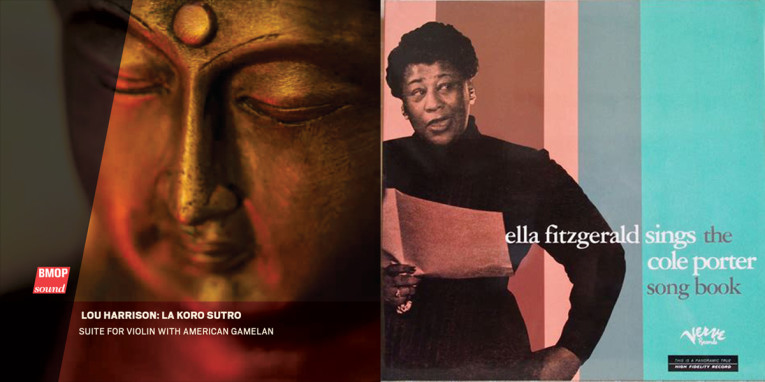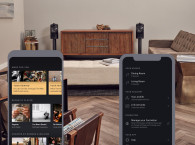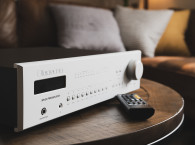QOBUZ: qobuz.com
and TIDAL: tidal.com

1. Donald Fagen, “Ruby Baby,” from The Nightfly (recorded 1981-82).
Sound Reinforcement professionals often use this track to fine-tune their PA setups in arena-sized Rock venues. If, in a 12,000-seat venue, it takes a little EQ to make the chattering “Party Noise” voices at the end of this song sound more intelligible and more distinguishable from each other; then, so be it. However, your loudspeaker design, in a normal room, should not need EQ. By the way, in 2010, the Vatican newspaper L'Osservatore Romano put The Nightfly on its list of Top 10 Albums. Really. You can look it up.
2. Enrico Caruso, “Ideale” (F.P. Tosti)(single, recorded 1906).
Italian opera singer Enrico Caruso (1873-1921) was the first superstar of the crank-up phonograph era. That was, at least in part, because there is a serendipitous synergy between the acoustical-horn 78-rpm recording process and male operatic voices. The horn’s internal resonances give a little extra heft and power to male voices, while the lossy mechanical coupling to the cutting stylus of the energy captured by the horn reduces high-frequency vocal “brassiness.” Caruso’s 78-rpm records sold tons of acoustical phonographs! Listen for the unavoidable artifacts; but also prepare to be surprised at how listenable his voice is. (The orchestra is a totally lost cause, sad to say.)
3. Franco Vassallo, “Ideale” (F.P. Tosti), from Arcano, Songs of Francisco Paolo Tosti (recorded 2021).
One hundred-fifteen years after Enrico Caruso stood in front of an acoustical horn, baritone Franco Vassallo recorded the same song, but in 24-bit/96kHz high-definition fidelity. Listen for all the little details, and for the micro and macro dynamics as Vassallo’s voice swells and soars. Also, be on the lookout for any stray loudspeaker resonances. BTW, the piano sound is stunningly natural.

4. Frank Sinatra, “I’m a Fool to Want You” (Sinatra, Wolf, and Herron), from Where Are You? (recorded 1957).
For all his flaws as a person (and at least before he began believing his own press releases), Frank Sinatra was a true artist of the American Popular Song. The album Where Are You is supposed to have been inspired (or perhaps triggered), by Ava Gardner’s break-up with Sinatra. Where Are You? is really a song cycle about wandering around town late at night, while hoping to run into your ex.
If you pay close attention, you can hear that small bits of one song are often woven into the instrumental setting of a different song. The mono version has twice the data density of the stereo version, so that is what I am going with. Listen for transient dynamic linearity, timbral coherence, and the lack of crossover-region artifacts.
5. Gordon Lightfoot, “If You Could Read My Mind” (Lightfoot), (recorded 1969).
One would be tempted to say that singers/songwriters have been with us since the time of the Troubadours of the Middle Ages (btw, Lady Troubadours were called Trobairitzes). However, that would perhaps be unfair to King David. Either way, from circa 1960 to 1980, singers/songwriters, from Bob Dylan and Joan Baez to James Taylor and Joni Mitchell, owned the airwaves and the charts.
Gordon Lightfoot’s evergreen breakthrough hit (mercifully) was recorded before Aphex Aural Exciters, to say nothing of Auto-Tune. At 06 seconds after the start, Lightfoot quietly breathes in through his nose as he gets ready to sing. If you can hear that from several feet away, you are listening to a high-resolution loudspeaker.
6. Ella Fitzgerald, “Easy to Love” from Ella Fitzgerald Sings the Cole Porter Songbook, (recorded 1956).
This mono track from 1956 is the decisive test for “phantom center imaging.” In addition, the timbre of Fitzgerald’s voice can reveal much about the all-important midrange in a music system — the midrange is where most of the real musical action takes place. Between verses, Ella briefly turns off-mic and politely swallows. If you can hear that from a listening distance of, say eight feet, then that loudspeaker is likely producing a finely detailed midrange that is also more phase-coherent than not.

7. Lisa Richard, “Never Have I” (Wakefield and Schwartz), from Virgin Tracks (recorded 2001-02).
From Ella Fitzgerald to Patricia Barber, audiophiles have craved a constant diet of Female Vocals. To the point that, at audio expos, some tracks get played and replayed to the point of it being just too much. Examples being “Famous Blue Raincoat” and “Ode to Billy Joe.” So, here’s a Female Vocal track that hardly anyone has ever heard. Really.
Reportedly, Jane Olivor commissioned this song. In any event, Olivor did take it on tour in 1982. However, for some reason, Olivor deleted it from the live LP of that tour, and she never made a commercial recording of it. Lisa Richard, having sung more than 1,300 live performances of Mama Mia, was putting together a self-produced solo album. The composer and the lyricist of “Never Have I” gave her permission to release a recording of the song. So, this is the first-and-only recording.
This is, in my opinion, the greatest “Jilted Girl” song performance in existence. Listen to the little break in her voice, as Richard portrays the Jilted Girl. The production values are of the 1990s “Everything, plus the Kitchen Sink” variety; but that only means that there is more art and craft to admire. Bernie Grundman mastered. The guitar solo by Danny Jacobs is amazing.
8. Patricia O’Callahan, “Real Emotional Girl” (Randy Newman), (recorded 2000).
The music business is fundamentally unfair. Therefore, it should not surprise anyone that cabaret singer Patricia O’Callahan really should be better known than she is. This, the title track of her first major-label release, shows off O’Callahan’s classical-voice training in the service of a chamber-music treatment of one of Randy Newman’s more somber, downbeat songs. This recording captures the rich harmonic complexity of O’Callahan’s voice very well.
9. Julia Fordham, “For You Only For You” (Fordham), from Porcelain (recorded 1989).
Julia Fordham embraced a variety of styles, from Singer-Songwriter to World Music to, every now and then, Retro. Her self-penned song “For You Only For You” has a bit of a Cole-Porteresque “List Song” vibe, as the singer names all the major rivers she has cried... “I cried the Solent, the Tyne, the Severn and the Rhine/The Thames and the Seine over again,” with a 1940s-style piano accompaniment.

10. Frederica von Stade, “La Delaïssádo” (Canteloube), from Frederica von Stade Sings Chants d‘Auvergne, Volume I (recorded 1982).
“The Abandoned (Shepherdess)” is a folk-song orchestration by Joseph Canteloube (1879-1957). Canteloube was a master of orchestration, creating lush textures that nevertheless managed not to eclipse the essential simplicity of the peasant songs he collected. Aided by Antonio de Almeida’s meticulously paced conducting, Frederica von Stade’s performance is a study in quiet intensity. Toward the end of the song, a piano at the rear of the orchestra adds some broken arpeggios to the mix. The piano should appear to be very much at the rear of the soundstage.
11. Cantus, ”Shenandoah” (trad., arr. J. Erb), from Let Your Voice Be Heard (recorded 2000).
A recording engineer I know told me that this was the best chamber vocal-group recording he had ever heard. Certainly, it is one of the best. The recording venue, of circa 500 seats, was chosen for its clear focused sound (in preference to a reverberant ”cathedral” sound). The 12 singers stood in a single-file arc in front of the microphones.
The microphones were a pair of spaced omnis six feet apart and nine feet off the stage floor, 13 feet from the singers. The omnis were supplemented by a (time-aligned) near-coincident ORTF pair 10 feet back from the edge of the stage. (John Atkinson recorded.) Listen for spatial and tonal realism. What singing!
12. Boston Modern Orchestra Project and Providence Singers, from La Koro Sutro (Lou Harrison), ”3a Paragrafo” (recorded 2009).
La Koro Sutro is a setting (in the constructed international auxiliary language Esperanto), for large unison chorus and percussion orchestra, of verses from the Buddhist ”Heart Sutras.” This particular recording (there actually is more than one) was made in Mechanics Hall, a historically significant concert hall in Worcester, MA. I have it upon good authority that Mechanics Hall is Yo-Yo Ma’s favorite place to record. Listen for how well the size of the recording venue (1,300 seats) is reproduced, as well as the placement and transient speed of the various shimmering percussion instruments.







